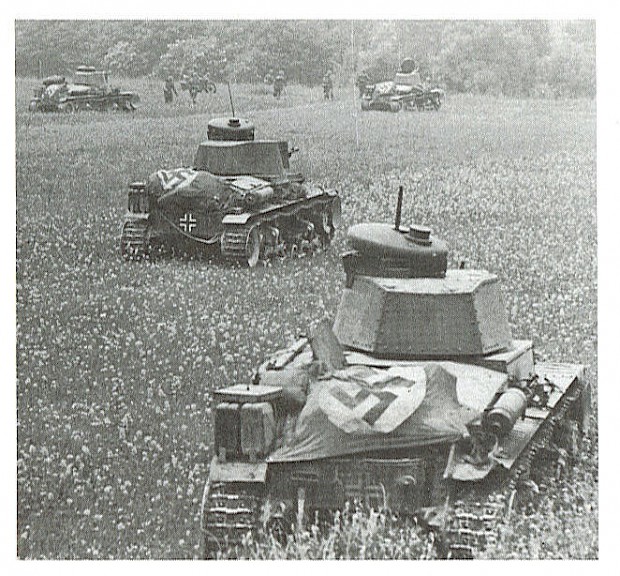Tank Lovers Group
Hobbies & Interests
This group is for everyone who like tanks, sci-fi tanks, real tanks, funny tanks, you can put here tank mods, tank maps, simply everything with straps, armor and gun :D
Blitzkrieg!
(view original)
Post a comment
Description
A brilliant warfare tactic invented by the German army (Whermacht).
It begins with air raids, followed by long range artillery assault, which is closely followed by mobilzed armour divisions. Foot soldiers then progress and swarm the enemy, ending in a fast Victory.
Was very effective in the early campaigns in France, Belgium, Poland, and to some extent Russia.






Ah, march of the light tanks is what is should've been called! Har Har!
Tier 1 spam ftw!
PzKpfw 35(t) is Tier 2 not 1
World of Tanks? :)
everything isn't world of tanks. I meant tier 1 as these where the tanks deployed before and during the early stages of the war. What in game would be called tier 1 :p
I like this image. Mostly because i haven't seen many images of 35(t)'s in combat though.
Nice find, tanker.
is a 5 min blitzkrieg possible
This has 2 major historical faults >>
1) Blitzkrieg was NOT invented by the Germans. It was first created and used by the British in WW1. It was fist to be implemented by Lieutenant Colonel John Fuller of the British Tank Corps & Third Army commander Julian Byng at the battlefield sited between the Canal du Nord and the St. Quentin Canal.
This was vetoed by British Commander-in-Chief ""Sir Douglas Haig"" who preferred to continue with operations at Passchendaele. Haig was later disappointed at the lack of progress at Passchendaele & turned back to Fuller and Byng's scheme, attracted by the notion of achieving a useful victory using the new weapon before the year was out.
Thus the attack was duly launched at dawn on the morning of 20 November 1917, with all available tanks advancing across a 10 km front. 476 tanks were accompanied by six infantry and two cavalry divisions (the latter to exploit any breakthrough), plus a further 1,000 guns. 14 newly formed squadrons of the Royal Flying Corps stood by - a forerunner of the blitzkrieg tactics employed to great effect by the German army during the Second World War. Notably the attack was not preceded by a preliminary bombardment, helping to ensure complete surprise.
Therefore Sir Douglas Haig, Lieutenant-Colonel John Fuller, & Army commander Julian Byng were the real creators of the blitzkrieg tactic.
2) The Germans did not use Blitzkrieg in Poland as it was in fact 1st used against France. In Poland the Germans were still experimenting with the idea and their tactics for the most part were the classic WW1 styled Schlieffen Plan with elements of blitzkrieg being developed as the campaign progressed.
Note that this dosent mean that Poland was defeated fairly. She was outnumbered and attacked by the Germans from 3 fronts and later attack by the Soviets who broke her last ditch defensive plan at the Romanian Bridgehead. Note that neither Germany nor the USSR formally declared war on Poland so in essence they were both surprise attacks especially with the Soviets as Poland at that time along with everyone else didn't think that the Russians would have made a treaty with Germany since at the time they were ideological opposites and more or less despised each other politically.
Basically Poland was only prepared to fight a rear guard war of attrition against Germany alone. Should the Soviets have stayed out of the war the Polish campaign would have dragged on for at least another month with Germany taking heavy losses and Polish forces would have been resupplied with arms, equipment, and man power from England via Romanian ports.
Static.howstuffworks.com
Firstly, You missed the point. I was actually meaning the term "Blitzkrieg" was first used by the Geramans, not the strategic meaning. I know of course that the sole tactic of "combining armed forces to attack concentrated posistions in a surprising offensive" was not invented by the Germans. But really, You don't need to flip out and write enitre book pages in the comment box... And apart from this, what do you mean "the Germans attacked Poland from 3 fronts"? the Germans did not attack Poland from 3 fronts. That would mean they attacked from the East + West + South or North. But the German offensive came only from the Western front.
Well technically you can argue 2 fronts since the was primarily from the south west and north via East Prussia. Just look at the map.
And to I didn't flip out I went into detail :/ I'm just a WW2 history nut so don't blame me for trying to correct inaccuracies especially when it come to early WW2 as many historical facts have been distorted or out right eliminated from the pages of history.
ok, that sounds like fliping out... just get over it guys...
Meh, Blitzkrieg is as much as a tactic invented by germany as shock and awe is invented by the americans.
I don't think anyone really invented Blitzkrieg. It was just a common thought.
All that really matters is whoever uses it to the greatest effect. For example, it wasn't the Americans who came up with the concept for an atomic bomb but since they used it first they're generally thought as the ones who came up with it.